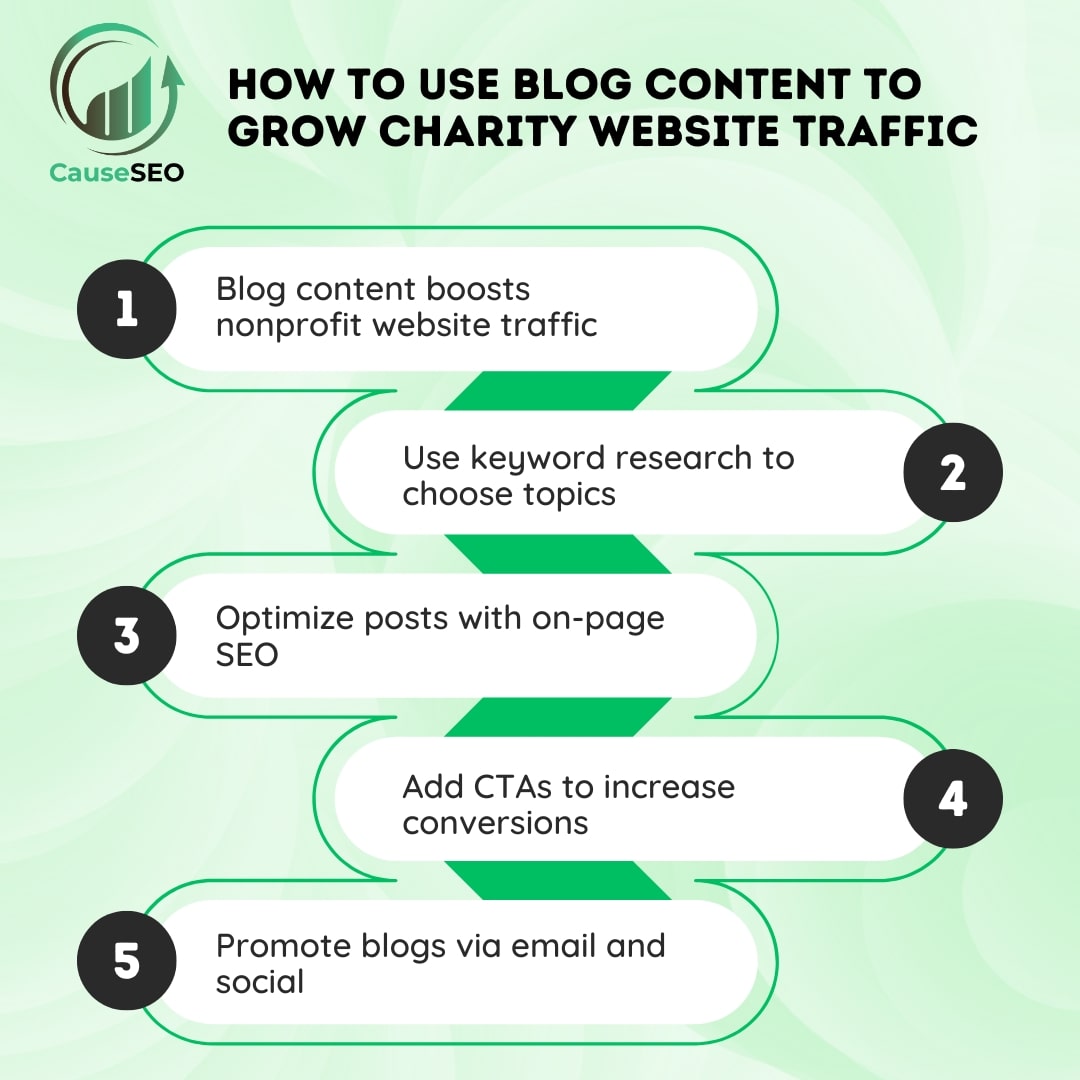Most nonprofits want to reach more people, but many overlook a simple tool that helps them do just that: blogging. When used strategically, blog content can increase your charity’s website traffic, improve your visibility in search engines, and bring in more donors and volunteers. That’s why learning how to use blog content to grow charity website traffic is an essential step for organizations that want to build awareness and connect with supporters in a consistent and cost-effective way.
In this post, we’ll break down how to use blog content to grow charity website traffic. You’ll learn how to choose the right topics, optimize your posts for search, drive more actions like donations, promote your content, and measure what works.

Why Blogging Helps Increase Website Traffic for Charities
Search Engine Visibility
People use search engines to find answers to specific questions like “how to donate used furniture in Toronto” or “volunteer opportunities near me.” When your charity publishes blog posts that match these types of searches, your website becomes more likely to show up in the results.
Publishing new blog content also signals to Google that your site is active. This improves indexing and helps boost your rankings over time, especially if you’re targeting long-tail keywords.
Audience Engagement and Trust
Blogging also helps humanize your nonprofit. Sharing real stories and updates from your programs builds trust with readers. Visitors stay longer on your site when the content feels personal and relevant, which can lower your bounce rate and improve your SEO in the process.
Choosing the Right Blog Topics for Your Cause
Use Keyword and Audience Research
Start with tools like Google Autosuggest, AnswerThePublic, or Ubersuggest to find what people are searching for. Focus on long-tail and question-based keywords like “how to help homeless people in winter” or “where to volunteer with kids.”
These types of searches often show user intent and are easier to rank for.
Align with Mission, Location, and Timeliness
Good blog topics also reflect your mission and community. For example:
- “How We Helped 200 Families in Detroit Last Winter”
- “Volunteer Opportunities for Teens in NYC”
- “What to Donate After a Flood in Manitoba”
These posts connect directly with your audience’s interests and make your content feel specific and local.
Use a Content Pillar Strategy
A smart way to organize blog content is by using content pillars. This means writing one long, comprehensive post like “Guide to Ending Hunger in Winnipeg,” then creating smaller blog posts under it such as “Best Local Food Banks,” “How to Host a Food Drive,” or “Tips for Donating Canned Goods.”
This structure supports internal linking and helps boost overall SEO for charities.

Optimizing Charity Blog Posts for SEO
On-Page SEO Elements
Place your target keyword in the blog title, H1 tag, and the first paragraph. Use variations in subheadings and image alt tags.
Don’t forget internal linking. If you’re writing about food drives, link to your donation or volunteer pages within the blog post. This helps Google understand your site’s structure and improves user navigation.
Clear Formatting for Readability
Use H2 and H3 headers to break up sections. Keep paragraphs short and easy to scan. Use bullet points or numbered lists where helpful.
Add relevant images or videos and make sure each has descriptive alt text. This helps both accessibility and SEO.
Optimize Meta Titles and Descriptions
Write a short and clear meta title that includes your keyword and location if possible, like “How to Help Local Families – Winnipeg Food Bank Guide.”
The meta description should briefly explain what the blog offers and why someone should click.
Using Blog Content to Drive Conversions and Actions
Add Strong CTAs
Every blog should end with a clear next step. Whether it’s “Donate Now,” “Sign Up to Volunteer,” or “Share This Post,” use buttons or inline links that stand out visually.
Match Blog Content to Donor/Volunteer Intent
Think about the goal of each blog post. Informational posts are good for attracting volunteers. Emotional stories might be better for encouraging donations. Event-related posts can direct readers to RSVP forms.
Embed Donation Forms or Links Strategically
You don’t need to push donations aggressively. Instead, place donation forms or links where they make sense naturally within the blog—such as after a story of impact or program update.
Promoting Blog Content to Expand Reach
Share on Social Media and Email
Break your blog into small snippets to share on social media. Pull a quote, a tip, or a photo and post it with a link to the full article.
Also include blogs in your newsletters. Use a brief teaser paragraph and link out to the full post on your site.
Collaborate with Partners and Local Media
Ask your partner organizations to share or link to your blog posts. Reach out to local media outlets or nonprofit listing sites and submit your content for reposting or mention.
Repurpose Blogs Into Other Formats
Turn blog posts into short videos, infographics, or social slideshows. These formats work well on platforms like Instagram or Facebook and can bring traffic back to your website.

Measuring Blog Impact and Improving Results
Track Key Metrics in Google Analytics
Use Google Analytics to monitor pageviews, bounce rate, average time on page, and conversions coming from blog traffic. This helps you understand which posts perform best.
Use Data to Guide New Topics
If a post about food banks gets 10 times more views than one about clothing donations, create more content on food programs. Look at clicks, signups, or donations to guide your future posts.
Maintain and Update Older Blogs
Review older posts every few months. Update stats, fix broken links, and improve formatting. Add internal links to newer content to keep everything connected.
FAQs About Blogging to Grow Charity Website Traffic
How often should a charity publish blog posts?
Aim for at least two posts per month. Consistency is more important than publishing every week.
What should a nonprofit blog about?
Program updates, volunteer stories, donation impact, how-to guides, and local events. Stay focused on what your audience wants to know.
Do blogs really bring in donations?
Yes. Blogs attract visitors, build trust, and lead them to take action when paired with the right CTAs.
Is it okay to repost blogs on other sites?
Yes, as long as you include canonical tags or only repost a portion with a link back to the original article.
Should blog content be written by staff or outsourced?
Either works. The key is that it matches your organization’s voice and shares accurate, meaningful content.
Conclusion
Blogging remains one of the most effective ways for nonprofits to grow their audience online. It builds visibility, educates supporters, and drives long-term engagement.
As donors and volunteers increasingly turn to the web to find causes to support, strategic blog content will only become more important. Starting is simple. Choose three to five real questions your audience is asking, write helpful answers, optimize them for search, and keep publishing consistently.
Looking for SEO services for charities or want to grow your nonprofit website traffic? Contact CauseSEO, a top SEO agency in Winnipeg offering the best SEO services for charities across Canada and beyond.

